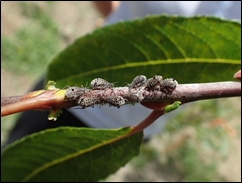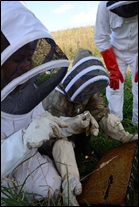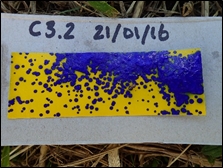PESTS AND DISEASES OF FORESTRY IN NEW ZEALAND
Monitoring giant willow aphid abundance in the Bay of Plenty
Scion is the leading provider of forest-related knowledge in New Zealand
Formerly known as the Forest Research Institute, Scion has been a leader in research relating to forest health for over 50 years. The Rotorua-based Crown Research Institute continues to provide science that will protect all forests from damage caused by insect pests, pathogens and weeds. The information presented below arises from these research activities.
From Forest Health News 263, February 2016.

Bay of Plenty Polytechnic student Julia Martin, hosted at Scion this summer, is developing methods to monitor the seasonal abundance of the recently introduced giant willow aphid, Tuberolachnus salignus (FH News 246 and 248). The giant willow aphid feeds on the sap of willow trees, and during this process, excretes copious amounts of honeydew that is readily gathered by honeydew feeders such as bees and wasps.

For apiarists, the “honeydew honey” that bees produce from this honeydew presents several problems. This type of honey is often referred to as “cement honey”. The sugars have low solubility and much of the honey crystalizes in the comb, making the extraction process difficult and thereby reducing yield. In addition, the jury is still out on whether the qualities of this type of honey are desirable to humans or not, and whether it provides good quality food for the bees for their winter survival.

Feeding by the giant willow aphid is also expected to negatively affect the health of its host trees, primarily willows (Salix spp.), as has been shown elsewhere. Willows are prized as key early season pollen and nectar resources for honey bees, among their many other uses such as flood protection and land stabilisation. Concerns from these various interest groups have led to scientists and bee industry players c ollaborating on a Sustainable Farming Fund bid.
In the meantime, Julia is travelling weekly to a Bay of Plenty Regional Council willow nursery in Whakatane, where she is attempting to make the link between aphid abundance and levels of cement honey being produced in nearby bee hives. The hives have been kindly provided by Golden Grove Apiaries.
Stephanie Sopow and Julia Martin
This information is intended for general interest only. It is not intended to be a substitute for specific specialist advice on any matter and should not be relied on for that purpose. Scion will not be liable for any direct, indirect, incidental, special, consequential or exemplary damages, loss of profits, or any other intangible losses that result from using the information provided on this site.
(Scion is the trading name of the New Zealand Forest Research Institute Limited.)

 Farm Forestry New Zealand
Farm Forestry New Zealand

